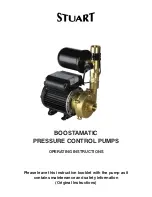
AF (6-36) IOM
21
SUCTION AND DISCHARGE PIPING
WARNING
NPSHA must always exceed NPSHR as shown on
Goulds performance curves received with order.
(Reference Hydraulic Institute for NPSH and pipe
friction values needed to evaluate suction piping
Properly installed suction piping is a necessity for
trouble-free pump operation. Suction piping should be
flushed BEFORE connection to the pump.
1. Use of elbows close to the pump suction flange
should be avoided. There should be a minimum of
2 pipe diameters of straight pipe between the
elbow and suction inlet. Where used, elbows
should be long radius.
2. Use suction pipe one or two sizes larger than the
pump suction, with a reducer at the suction flange.
Suction piping should never be of smaller diameter
than the pump suction.
3. To prevent suction cavitation, horizontal reducers
should be eccentric with the sloping side down
and concentric for vertical applications.
4. Pump must never be throttled on suction side.
5. Separate suction lines are recommended when
more than one pump is operating from the same
source of supply.
Suction lift conditions
1. Suction pipe must be free from air pockets.
2. Suction piping must slope upwards to pump.
3. All joints must be airtight.
Suction head/Flooded suction conditions
1. An isolation valve should be installed in the
suction line at least two pipe diameters from the
suction to permit closing of the line for pump
inspection and maintenance.
2. Keep suction pipe free from air pockets.
3. Piping should be level or slope gradually
downward from the source of supply.
4. No portion of the piping should extend below
pump suction flange.
5. The size of entrance from supply should be one or
two sizes larger than the suction pipe.
6. The suction pipe must be adequately submerged
below the liquid surface to prevent vortices and air
entrainment at the supply.
Discharge piping
1. Isolation and check valves should be installed in
discharge line. Locate the check valve between
isolation valve and pump, this will permit
inspection of the check valve. The isolation valve
is required for priming, regulation of flow, and for
inspection and maintenance of pump. The check
valve prevents pump or seal damage due to
reverse flow through the pump when the driver is
turned off.
2. Increasers, if used, should be placed between
pump and check valves.
3. Cushioning devices should be used to protect the
pump from surges and water hammer if quick-
closing valves are installed in system.
Final Piping Check
1. Rotate shaft several times by hand to be sure that
there is no binding and all parts are free.
2. Check alignment, per the impeller alignment
procedure outlined on pg. 26 to determine
absence of pipe strain. If pipe strain exists,
correct piping.
DRIVE ALIGNMENT PROCEDURES
Alignment procedures must be followed to
prevent unintended contact of rotating parts.
Follow coupling manufacturer’s installation
and operation procedures.
WARNING
Before beginning any alignment procedure, make
sure driver power is locked out. Failure to lock out
driver power will result in serious physical injury.
Lock out driver power to prevent electric
shock, accidental start-up and physical
injury.
3
!
!
Содержание Goulds Pumps AF
Страница 1: ...Installation Operation and Maintenance Instructions Model AF 6 36 MXR Bearings ...
Страница 3: ...AF 6 36 IOM 6 THIS PAGE INTENTIONALLY LEFT BLANK ...
Страница 5: ...AF 6 36 IOM 8 THIS PAGE INTENTIONALLY LEFT BLANK ...
Страница 14: ...10 AF 6 36 IOM THIS PAGE INTENTIONALLY LEFT BLANK ...
Страница 32: ...28 AF 6 36 IOM ...
Страница 34: ...30 AF 6 36 IOM THIS PAGE INTENTIONALLY LEFT BLANK ...
Страница 48: ...44 AF 6 36 IOM THIS PAGE INTENTIONALLY LEFT BLANK ...
Страница 66: ...62 AF 6 36 IOM AF SECTIONAL shown with optional restrictor bushing adapter Fig 77 ...
Страница 68: ...64 AF 6 36 IOM AF OPTIONS Fig 78 351 370F 126 ...
Страница 69: ...AF 6 36 IOM 65 MXR BEARING CONFIGURATIONS 1MXR 3MXR 4MXR 6MXR Fig 79 540C 6 ...
Страница 72: ...68 AF 6 36 IOM THIS PAGE INTENTIONALLY LEFT BLANK ...
















































